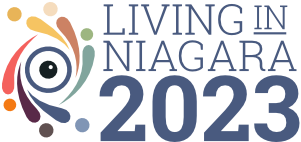Building an accurate description of prosperity for Niagara requires looking both through traditional economic growth lenses; and looking at data in and across the 12 Living in Niagara quality of life Sectors. Niagara appears poised for growth. Projections show that by 2041, the region’s population will grow by 160,000 people, and the number of jobs will increase by 150,000. In light of the national trend toward more jobs available at both lower and higher income levels, it will be important to pay attention to effects on 2 groups: those who are precariously employed; and mid-income earners who will have fewer financial resources for their families, and less spending power.
National Context
The 2016 Canadian Index of Wellbeing (CIW) National Report, ‘How are Canadians Really Doing?’ tracks 64 Indicators in 8 Domains, from 1994 to 2014. CIW findings point to the massive gap between Canada’s GDP (Gross Domestic Product) and the wellbeing of Canadians. To address inequality in income, health and access to engaging in the community, several policy directions are recommended:
- Provide a universal basic income as part of social assistance to reduce income inequality
- Adopt a pan-Canadian education strategy
- Focus on an ‘upstream’ approach for health promotion
- Leverage community resources through collaboration
- Provide universal access to leisure and culture
- Improve social and environmental data collection
Source: Canadian Index of Wellbeing National Report, 2016
Rating
Economic Prosperity
How Niagara is doing in the Economic Prosperity Sector in 2017:
3 – Of concern, requires attention
Amount of progress currently being made in the Economic Prosperity Sector in Niagara in 2017:
B – Moderate progress is being made
Happening Now
- Indigenous organizations in Niagara are describing their community in terms of employment and education rates, demographics, cultural heritage, resilience and racism barriers that exist. This information is shared to support employers seeking to hire and retain Indigenous employees, Indigenous job-seekers, and people building toward a stronger future.
- Small to medium-size enterprises (SMEs) in Niagara have access to a variety of resources to support growth and increased productivity, such as: Niagara Foreign Trade Zone (FTZ) support for export development; horticultural automation research at Vineland Research and Innovation Centre; onsite work spaces for companies at the Niagara College Walker Advanced Manufacturing Innovation Centre in Welland; digital equipment, and opportunities to collaborate at the Generator at One and iHub in St Catharines; and Health and Bioscience research support at Goodman School of Business Biolinc at Brock University.
- The 2016 Census of Agriculture shows there are 1,827 farms covering 218,251 acres in Niagara, with gross farm receipts of over $838 million; and 2,615 farm operators who are on average 56 years of age. 2016-2017 Niagara Employment Inventory data will align with that for the other 6 regions in the Golden Horseshoe, to strengthen the agri-food business cluster that generates an estimated $12.3 billion in economic activity in Niagara, Hamilton and the GTA.
- Niagara Region is a partner in the SWIFT Network project to build an ultra high-speed fibre optic Internet network to support business growth in rural areas; secure provincial and federal government investment in improving Niagara’s information infrastructure; and better connect rural residents with online information and services.
- Data is being developed as a valuable resource for Niagara. The 2015 provincial GO Open Data conference was hosted in the region; 8 municipalities are among the organizations sharing datasets on niagaraopendata.ca; and Niagara Connects is facilitating construction of the Niagara Data Repository and Refinery tool.
What’s Emerging
- Niagara-focused evidence that describes Living Wage, Cost of Living and rates of income precarity is being examined in light of Ontario’s minimum wage increase; and the national trend toward a decreasing number of jobs for mid-income earners and more jobs available at both lower and higher income levels.
- Niagara is experiencing industrial growth and related employment and training opportunities. The new General Electric manufacturing facility slated to open in Welland in 2018, and greenhouses transitioning to cannabis production are two examples.
- A review of 2006 and 2014 income quintile data for Niagara in support of the #Rethink Niagara initiative shows there are still approximately 65,000 people living on $12,000/year or less, and this costs all of us, collectively in Niagara, at least $1.38 billion a year in both direct and indirect economic costs.
- Niagara groups are aligning priorities with various adjacent regions through: Niagara-Hamilton Trade Corridor research to support development of the Niagara Region Transportation Master Plan; Golden Horseshoe Food and Farming Alliance work to strengthen the significant agri-food cluster in Canada’s most densely-populated region; and a Buffalo-Niagara-Hamilton exploration of opportunities for cross-border innovation and trade.
- Work is underway through the #Rethink Niagara initiative, to build a nuanced map of Niagara that describes adult literacy in all of its present-day forms, including digital competencies, communication skills, problem-solving ability and financial literacy.
Suggested Action Steps
- Create the conditions for increasing quality of jobs and productivity, and growing the talent pool that attracts businesses to Niagara. Do this by focusing on building a continuum of opportunity that allows people to get to the next level of employment and advance on career pathways.
- Continue to engage Indigenous and non-Indigenous people in building a more inclusive Niagara in all aspects, by working together to increase respect, understanding, and participation of Indigenous people in community, social and economic relationships.
- Pay attention to new ways people in Niagara are building economic prosperity, through increasing numbers of Independent Workers; online connectivity and global digital reach; social enterprise; and demographic trends that support inclusivity, social succession and inter-generational mentoring and investment.
- Build on Data and Knowledge Niagara Reference Group work to describe how data is being used by people, organizations, businesses and networks in Niagara.
- Advance #Rethink Niagara by weaving together data from existing initiatives, to remove or reduce barriers so that people can participate in the economy and have the capacity to be able to build up their own financial security.
Indicators
Economic Development in Niagara
- Economic Performance and Growth
- Number of Businesses in Niagara
- Organizations Contributing to Economic Development in Niagara
Income and Earnings in Niagara
- Low Income Measure in Niagara
- Income Levels in Niagara
- Market Basket Measure (MBM)
- Food Security, Food Bank Use, Hunger Count in Niagara
- Social Assistance in Niagara
- Number of Personal and Business Bankruptcies in Niagara
- Niagara Poverty Reduction and Prosperity Initiatives







